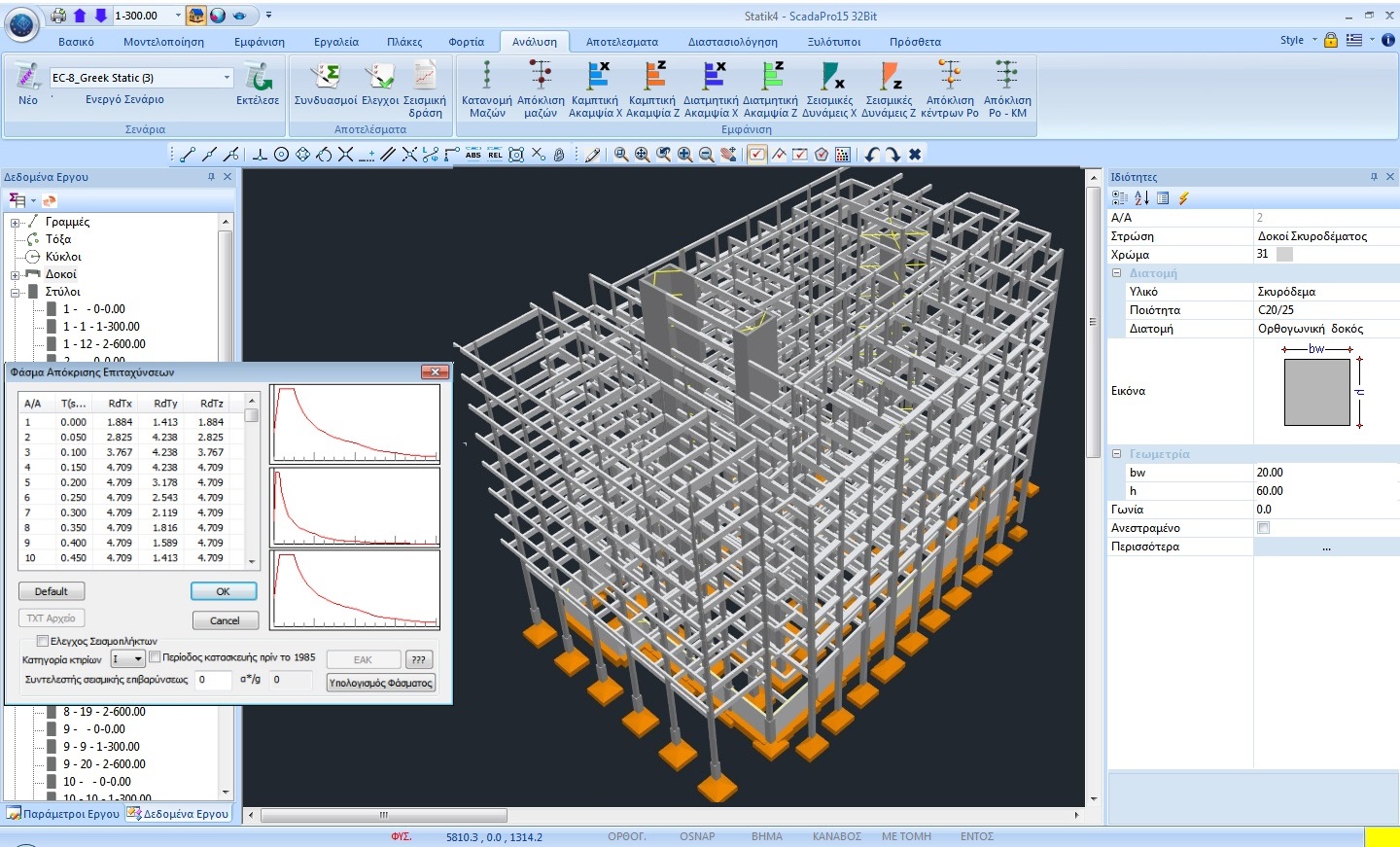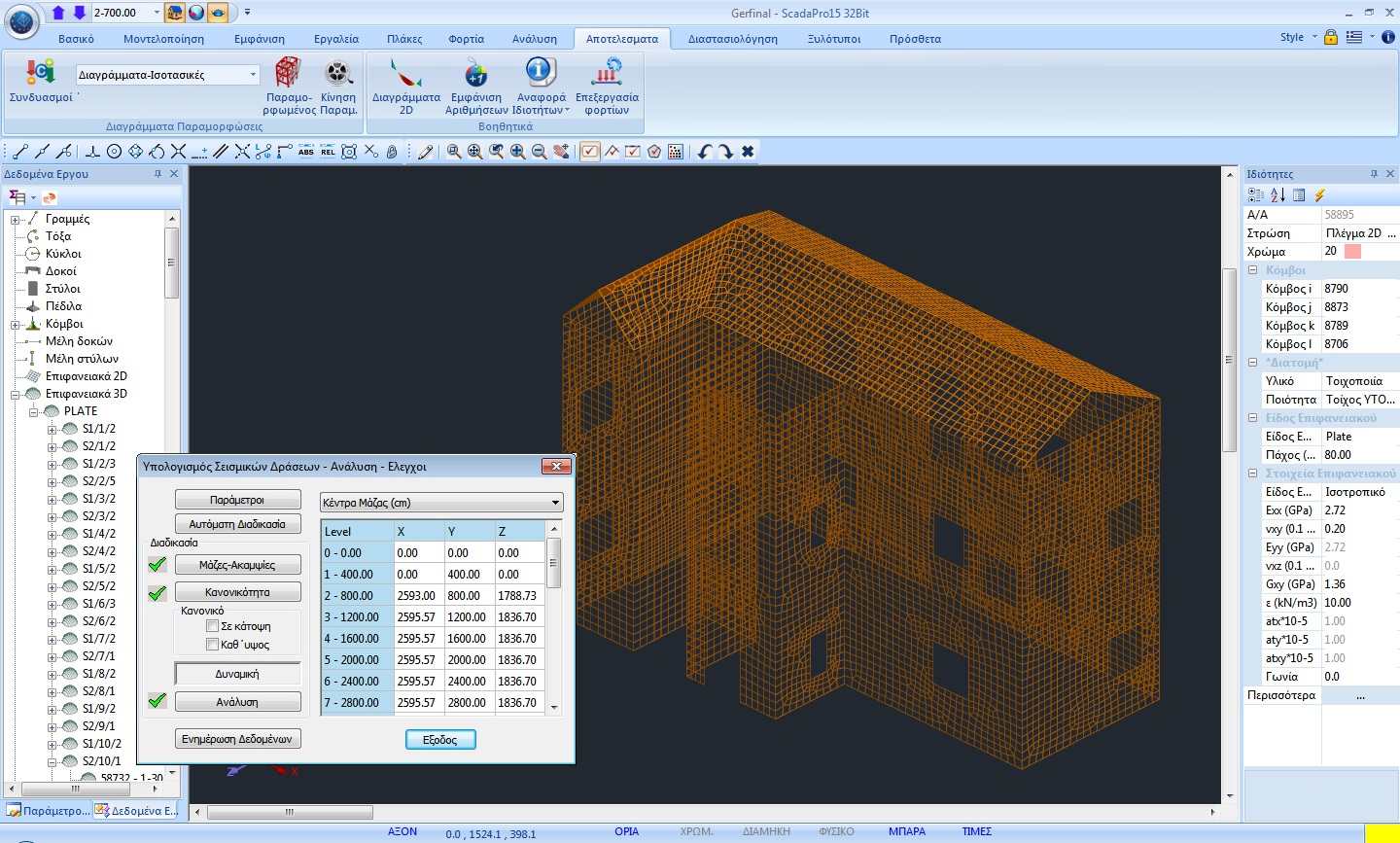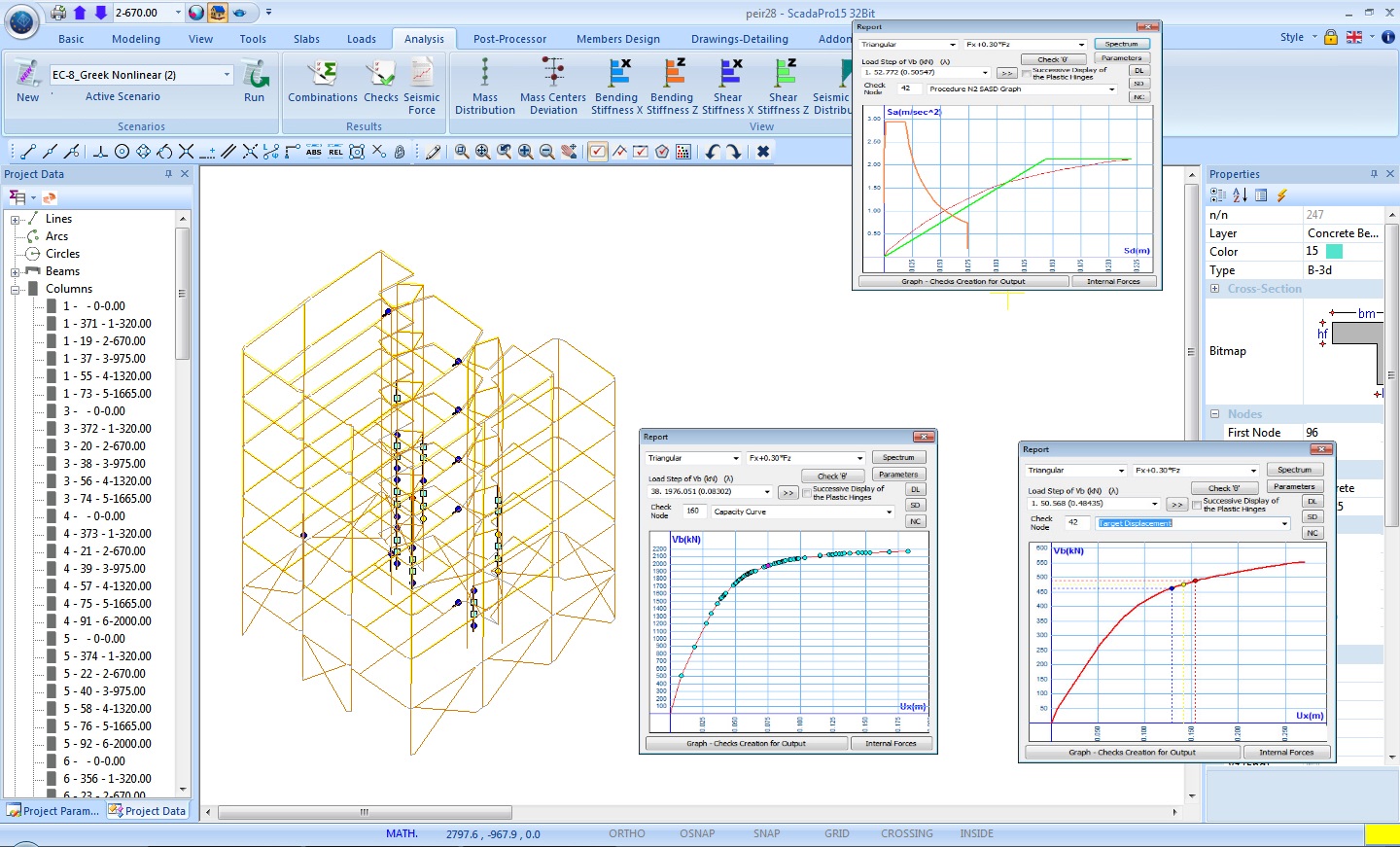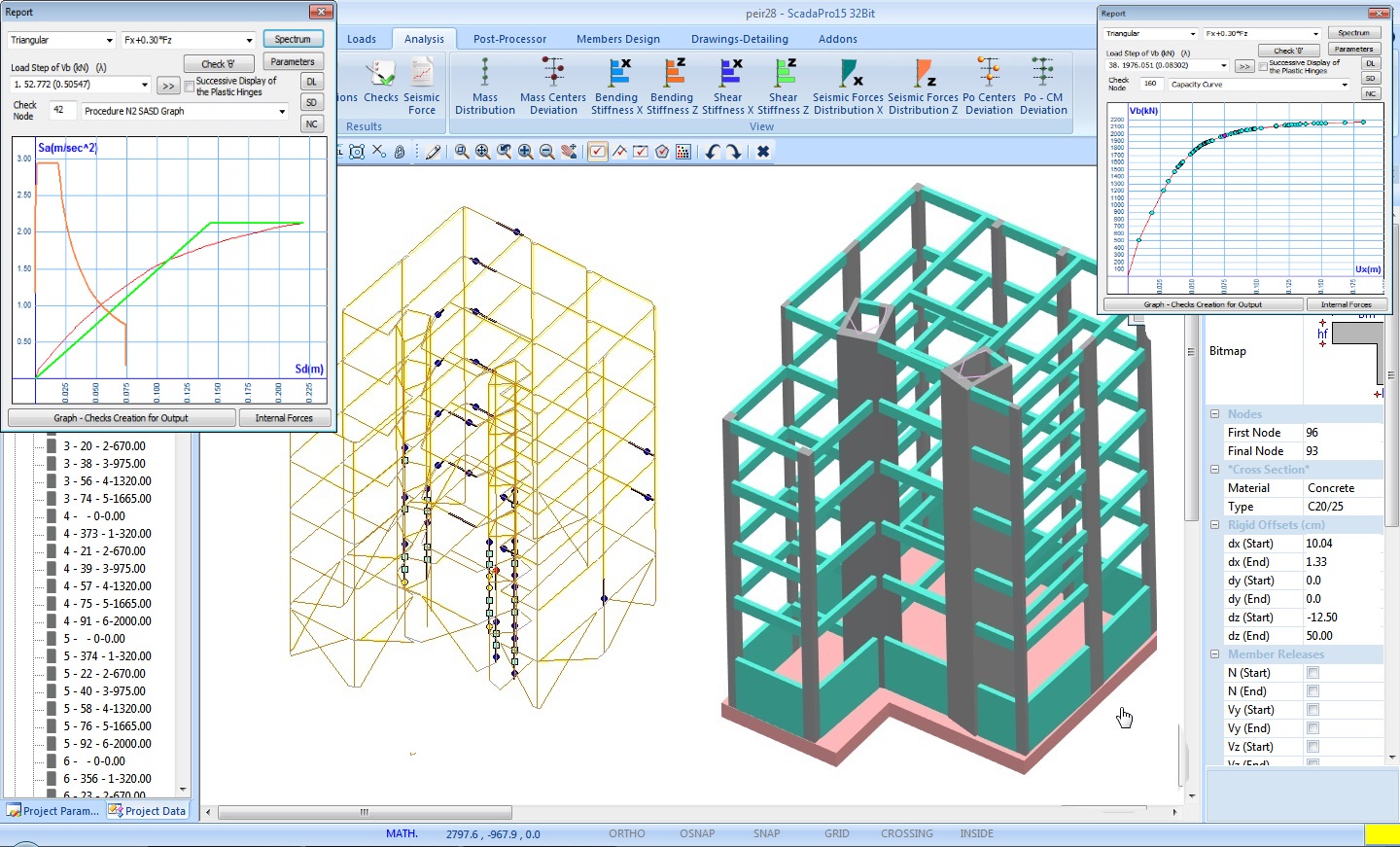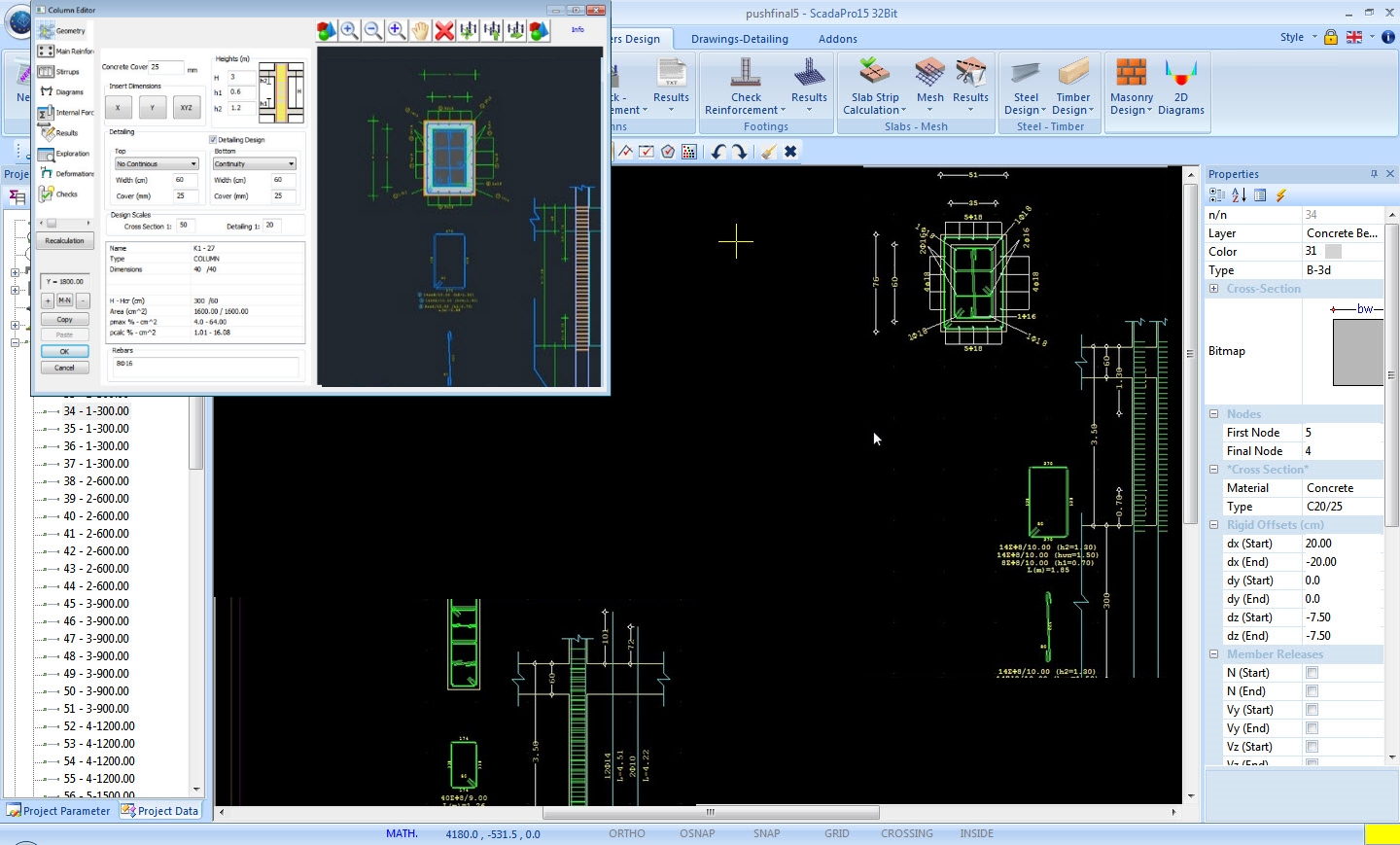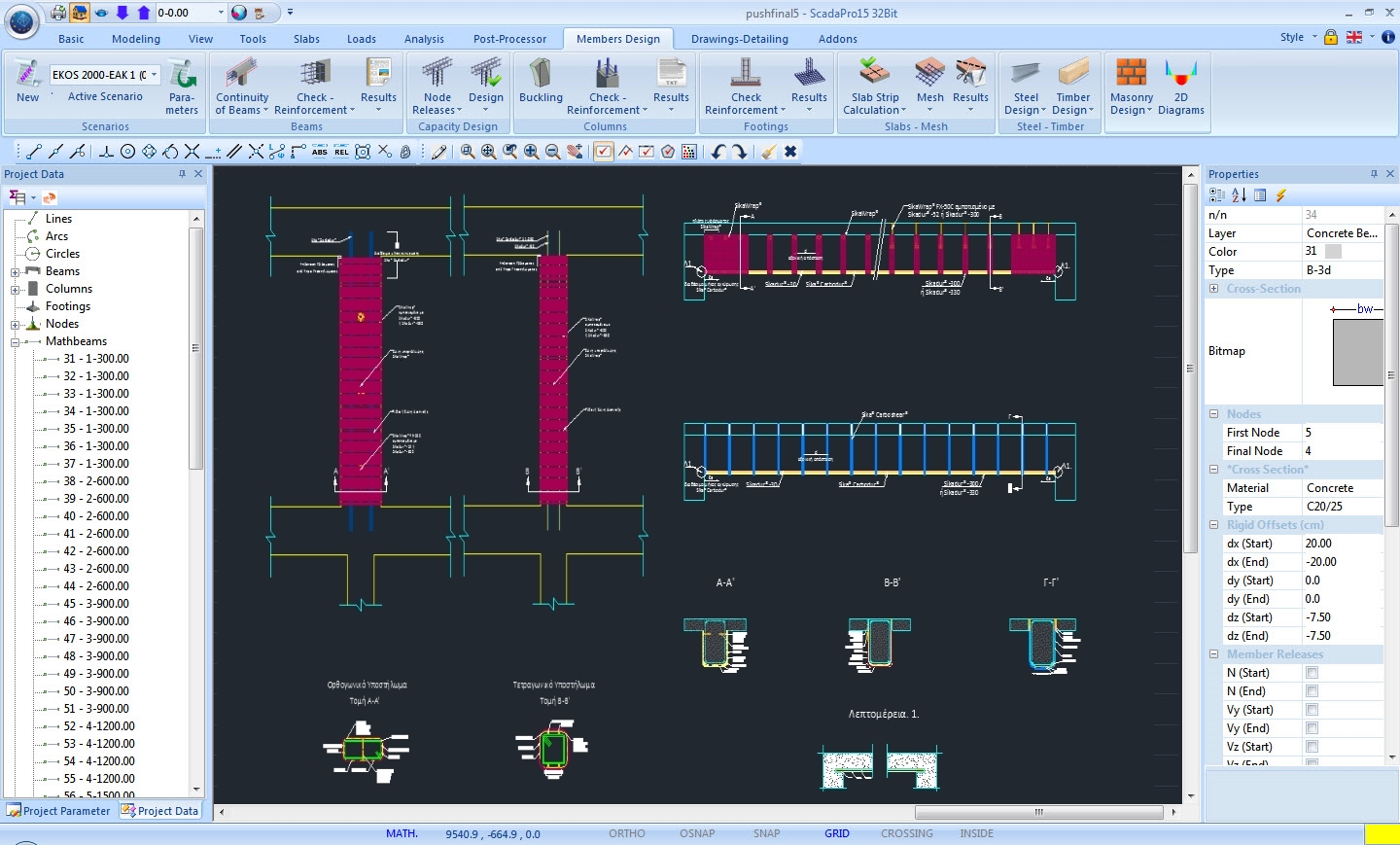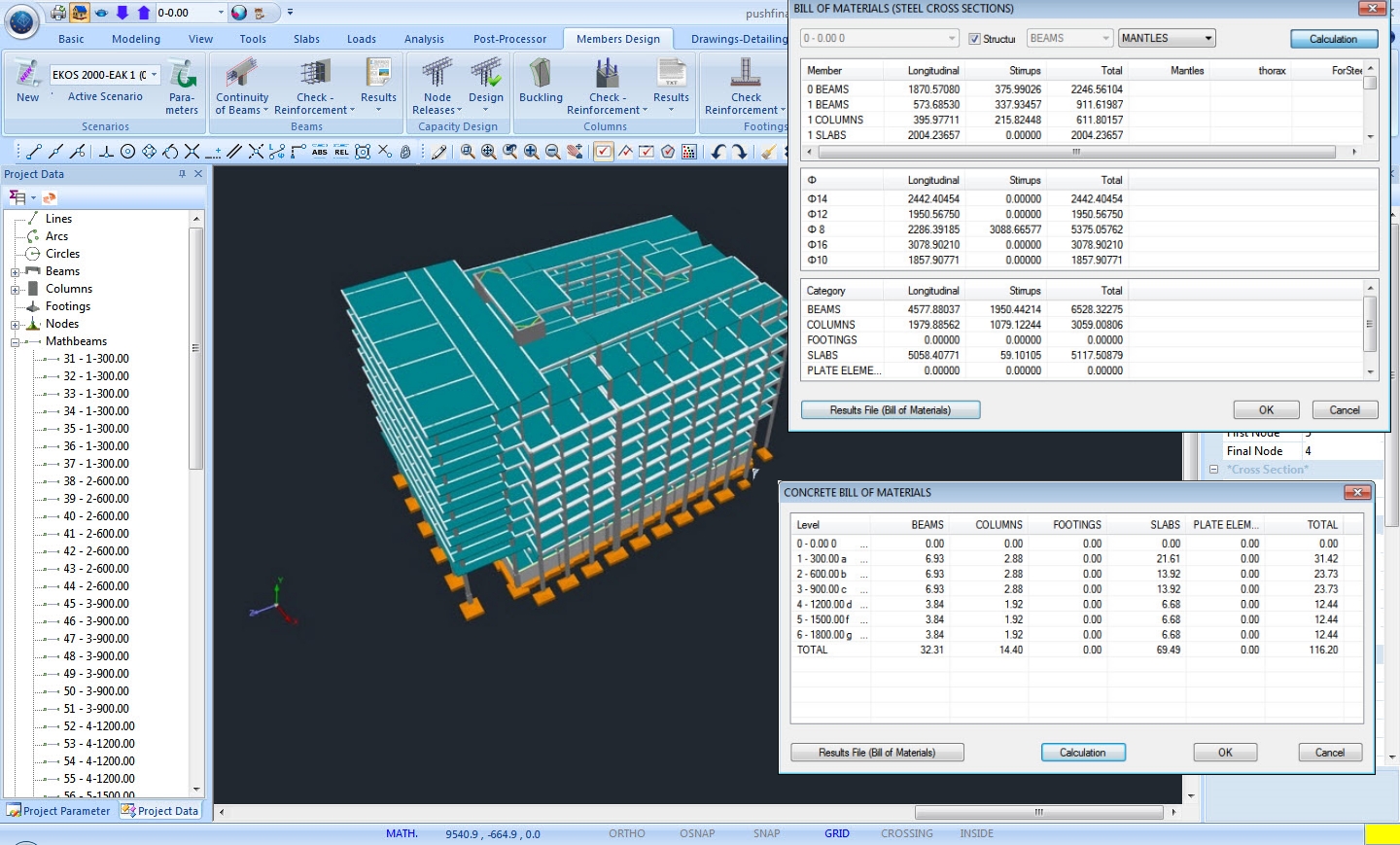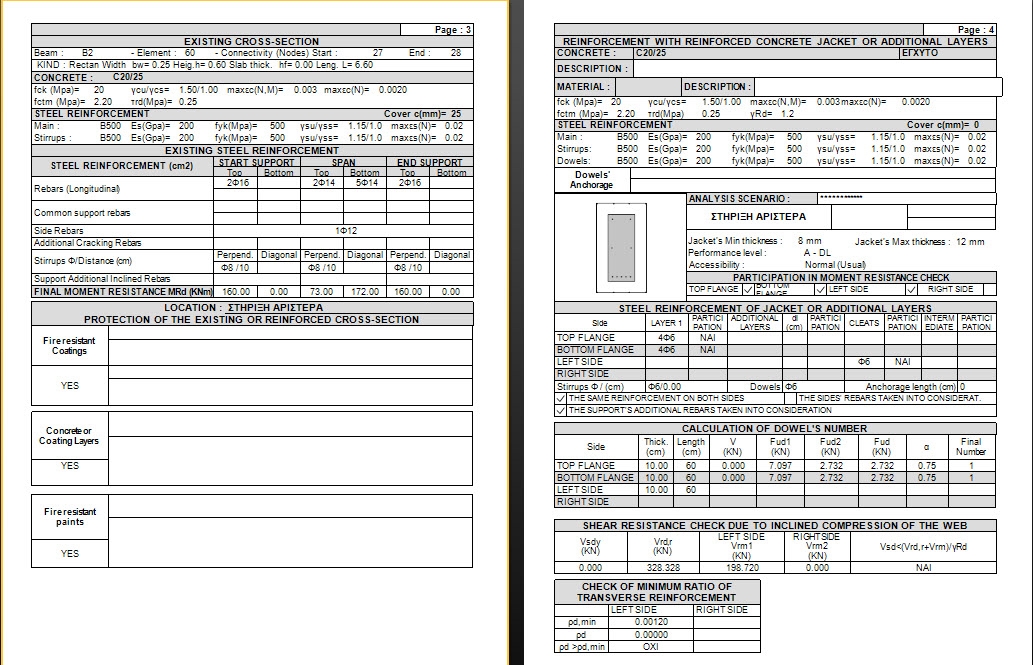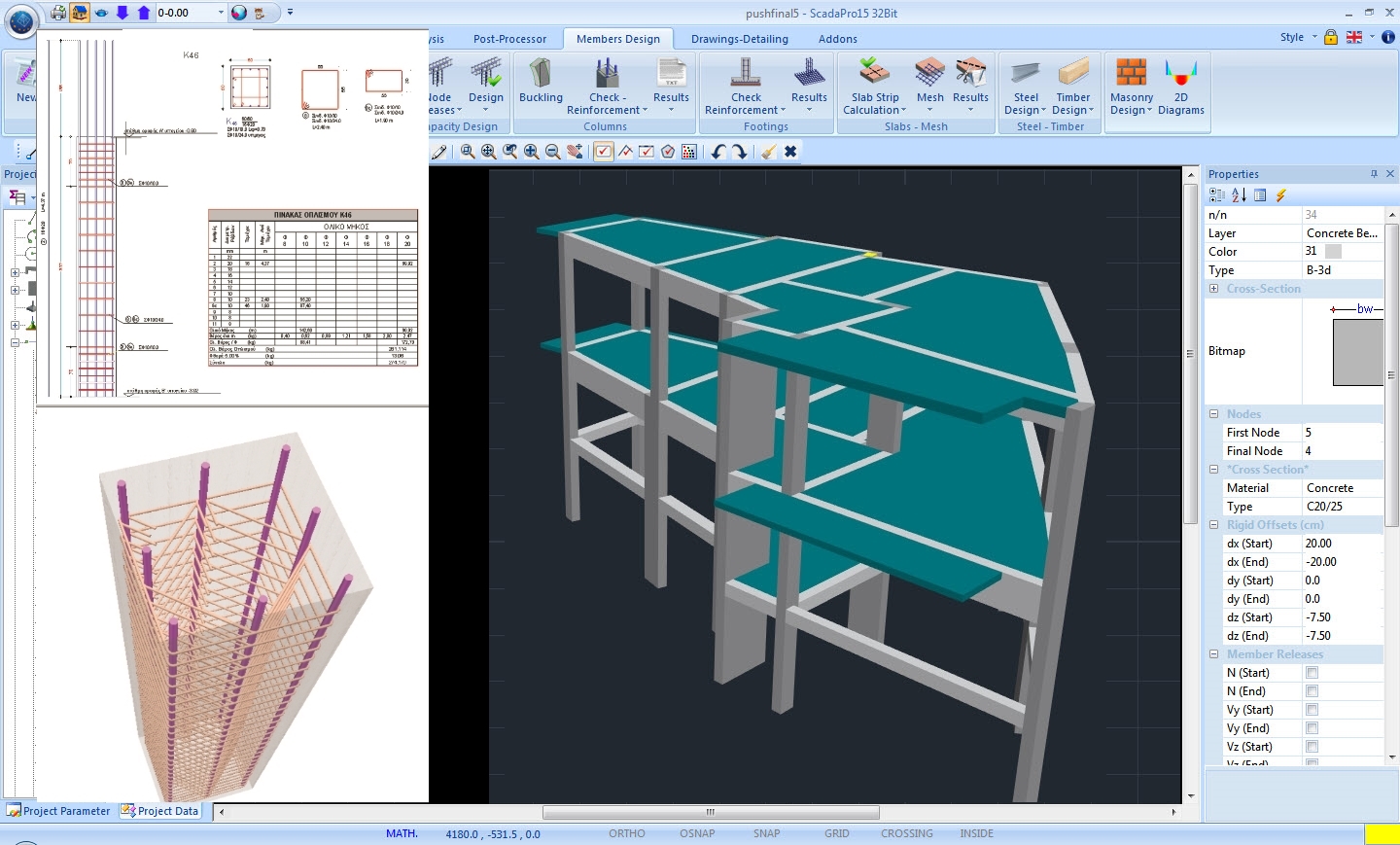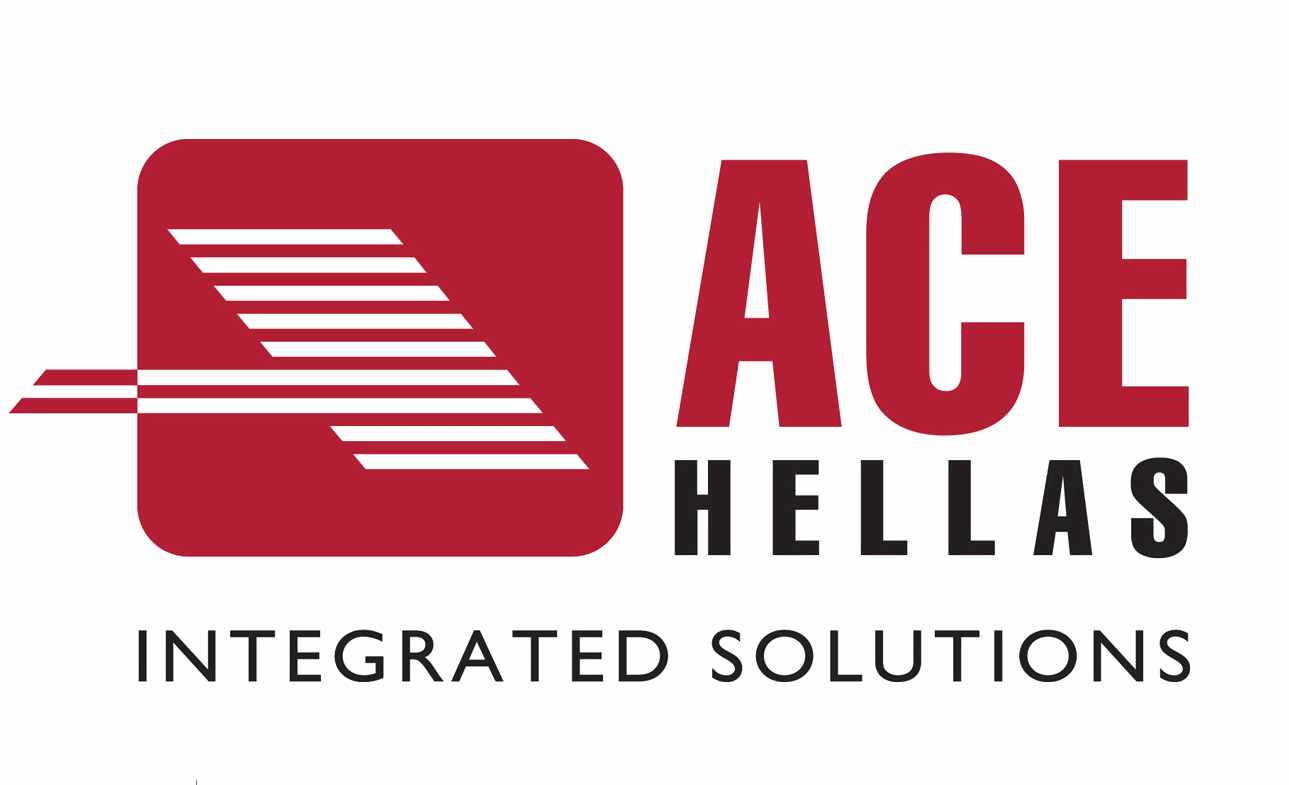Reinforcement technics to existing columns and beams cross-sections
Retrofit for Concrete +
The add-on Retrofit for Concrete includes the provisions and controls of KAN.EPE. for the valuation and redesign of existing buildings.
The add-on “Retrofit for Concrete” contains the Eurocode 8, Part 3 (EN1998-3) provisions and design checks for the assessment and redesign of existing buildings and for the application of reinforcement technics to existing columns and beams cross-sections.
The structure can be analyzed by applying the nonlinear static analysis method. It also includes production of the construction plans, formworks and reinforcement detailing, the bill of materials and full production of the technical report.
Prerequisites:
Analysis Methods
Preliminary design performing linear static analysis method
Preliminary design performing response spectrum analysis method
Linear static analysis considering two methods based on (i) the behavior factor q and (ii) the local ductility factors m
Response spectrum analysis considering two methods based on (i) the uniform behavior factor q and (ii) the local ductility factors m
Nonlinear static analysis method (Pushover)
Nonlinear static analysis (Pushover)
The nonlinear static analysis (Pushover) leads to a more reliable estimation of the structural performance, a more realistic assessment of the deformed structure and provide information about the performance of the structural elements that cannot provide the linear analysis methods.
The main scope of a nonlinear analysis is the assessment and the calculation of the nonlinear deformations as well as the stress resultants on the structure under seismic loads.
According to the Pushover analysis, horizontal lateral loads are applied on the structural model as well as the corresponding nodes and structural elements.
The distribution of the lateral loads along height (uniform, rectangular, triangular) is defined according to the seismic inertia forces.
The lateral loads are increased incrementally until the structure turns to mechanism and collapse.
During the analysis, once a cross-section yields (development of a plastic hinge) the model is modified properly and the incremental process of the lateral loads continues.
The control check is based on a nonlinear relation of the bending moment – plastic hinge rotation defined for each structural member.
For each analysis step is examined if the value of the bending moments developed on the structural element exceed the corresponding value of the yield moment.
In case there is an excess of the yield moment, a plastic hinge is developed in the edge of the element.
Nonlinear static analysis (Pushover)
In each step of the Pushover analysis, is also calculated the base shear force and the corresponding translation of a characteristic node (“control node”), usually located on top floor of the structure.
The main result of the pushover analysis is the derivation of the Force (base shear) – Displacement curve, also called capacity curve.
The curve derived from the pair values of the base shear force – top floor displacement is representative for the structural performance under seismic loading.
The nonlinear static analysis, also, provides information and complete supervision of the generating sequence of the plastic hinges on the structural elements.
The engineer has a complete display of each step of the gradual deformed structure and so can easily and quickly detects the “weak” regions of the structure.
In SCADA Pro the nonlinear analysis method is fully implemented.
All the requisite analyses are performed automatically considering default parameters, all the performance criteria according to EN1998-3 provisions are checked automatically and the corresponding results are presented in a direct and supervisory way.
Linear analysis methods and preliminary design according to Eurocode 8, Part 3 (EN1998-3) provisions
In the preliminary design are checked the criteria of EN1998-3 fulfilled in order to be applied either linear or nonlinear analysis and the corresponding results as well as the insufficiency indices λ are print out.
In the linear elastic analysis there is the option of two methods:
- the uniform behavior facto q method and
- the local ductility factors m method.
Also, the check about the evaluation of either brittle or ductile behavior of the structural elements is applied according two three criteria of EN1998-3:
- the moment shear ratio αs,
- the ductility demand ratio in terms of curvatures μ1/r,
- the ductility demand ratio in terms of deformations μd.
It is also taken into consideration the effect of the presence of masonry infills in the structure according to the EN1998-3 provisions and it is automatically calculated their capacity.
Nonlinear static analysis (Pushover)
In SCADA Pro all the requisite seismic load combinations are included based on rectangular or triangular distribution of the lateral loads.
The target displacement is calculated according to EN1998-3 and EN1998-1-1, Annex B provisions.
The capacity curve and the equivalent bilinear curve are drawn for the corresponding “control node”.
Along the capacity curve, the target displacements are depicted that correspond to each performance level.
There is also the capability, the masonry infills to be included to the structural model and their capacity to be calculated automatically in each step of the Pushover analysis.
Creation of structural drawings – Layout and detailing of reinforcement (EC2)
Powerful editor for the automatic creation of structural drawings
SCADA Pro provides a modern stand-alone editor for the creation of structural drawings.
A rich toolbox is offered, that contains ready-to-use symbols, annotations and sketching details, as well as special commands.
Any edit is incorporated, real time, in the drawings, including automatic re-check of the section takes place.
After that, the reinforcement is updated in the editing environment.
The layout of the beams’ reinforcement may be automatically derived with the respective bending moment diagrams.
The layout of a column’s reinforcement may be derived either for a certain level or for its whole height. The structural drawings may be exported in a .dwg or a .dxf file type.
Bill of materials
Accurate estimation of the bill of materials
SCADA Pro produces the quantities of all the materials of a project in a well-organized tabular form.
For the concrete, the quantities are presented per type of structural member (beams, columns etc.), per level or for the entire structure.
For the reinforcement, the quantities are presented per type of structural member, per each member or per bar diameter.
This grouping is available for each floor or for the entire structure.
Similarly, for steel structures, the bill of materials is available per floor, per member’s section or per type of structural member (columns, beams, girders, purlins, bracing etc.).
Report of the project
User friendly interface for the creation and editing of the report
In SCADA Pro the user simply selects the sections to be included in the report of the project.
Simple tools allow the user to edit the report header and footer position chapters and create automatically the table of contents.
Beams’ results also include envelope diagrams of internal forces.
The report may be previewed before the user can save it for further editing in one of the following file formats: RTF, PDF, HTML, PPTX, XLSX.
The results of both the assessment – redesign of the reinforced concrete structures as well as the design of loadbearing masonry structures are also presented in a well-organized, format.
Accompanying drawings and other details are also available and included for better reporting.


